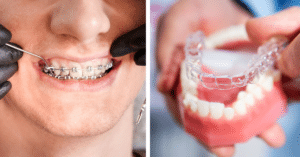The orthodontic treatment goes beyond just cosmetic improvements. It can have a significant impact on your oral health and overall well-being. Straight teeth not only look great but also function better. However, people seeking treatment are left with a difficult choice between Invisalign vs. braces. Which is better for you and your lifestyle?
Understanding Orthodontic Treatment
Before we dive into the specifics of Invisalign and braces, let’s take a moment to understand the basics of orthodontic treatment.
What Is Orthodontics?
Orthodontics is a specialized branch of dentistry that focuses on diagnosing, preventing, and treating dental and facial irregularities. These irregularities often manifest as crooked teeth, misaligned jaws, or bite problems. Orthodontic treatment aims to correct these issues, resulting in a well-aligned and harmonious smile.
Why Is It Important?
Having properly aligned teeth and a balanced bite is not just about aesthetics. It’s about improving your overall oral health and quality of life. Here’s why orthodontic treatment matters:
- Oral Health: Straight teeth are easier to clean and maintain, reducing the risk of tooth decay and gum disease.
- Improved Bite: A well-aligned bite can prevent issues like jaw pain, headaches, and uneven wear on your teeth.
- Confidence: A beautiful smile can boost your self-esteem and confidence in both personal and professional settings.
#1 – Traditional Braces

Traditional braces have been a trusted and effective orthodontic treatment for decades. They consist of several key components, including brackets, wires, and bands. Here’s a brief overview of each and their roles:
- Brackets: These are small, square-shaped pieces that are bonded to the front of each tooth using a special adhesive. Brackets serve as anchors for the other components of braces.
- Wires: Thin metal wires connect the brackets and provide the necessary pressure to gradually move your teeth into their desired positions. Your orthodontist periodically adjusts these wires to ensure proper alignment.
- Bands: Bands, also known as orthodontic bands, are metal rings that fit around your back molars. They provide stability and support for the entire brace structure.
Treatment Process with Traditional Braces
In the Invisalign vs. braces debate, the journey with traditional braces typically consists of several stages:
- Consultation: You’ll begin with an initial consultation with your orthodontist, who will assess your oral health and discuss your treatment plan.
- Braces Placement: During this appointment, your orthodontist will attach the brackets to your teeth and connect them with the wires and bands.
- Regular Adjustments: Throughout your treatment, you’ll visit your orthodontist for adjustments, where the wires will be tightened or replaced to continue guiding your teeth into their correct positions.
- Maintenance: Proper oral hygiene and maintenance are crucial while wearing braces. You’ll need to clean your teeth thoroughly to prevent plaque buildup and potential dental issues.
Advantages of Traditional Braces
Traditional braces offer several advantages:
- Effectiveness: They are highly effective for correcting complex orthodontic issues, including severe misalignments and bite problems.
- Lower Cost: Traditional braces tend to be more budget-friendly compared to some alternative treatments.
- Durability: Braces are made of sturdy materials that can withstand various daily activities and dietary choices.
Disadvantages of Traditional Braces
However, traditional braces also come with some downsides:
- Aesthetics: The most obvious drawback is their appearance. Metal brackets and wires can be quite conspicuous, which may affect your self-esteem, especially for teenagers and adults.
- Maintenance and Oral Hygiene: Cleaning around braces can be challenging, and you’ll need to be diligent to avoid plaque buildup, cavities, and gum problems.
- Discomfort and Adjustments: Adjustments can cause soreness and discomfort, and there may be dietary restrictions to prevent damage to the braces.
#2 – Invisalign

Invisalign is a modern and innovative alternative to traditional braces that has gained popularity for its discreet appearance and convenience. It uses a series of clear, custom-made aligners to straighten your teeth gradually. These aligners are made of a smooth, transparent plastic material that fits snugly over your teeth, making them virtually invisible when worn.
How the Invisalign System Works
To decide between Invisalign vs. braces, here’s a step-by-step explanation of how the Invisalign treatment process typically works:
- Consultation: Like with traditional braces, your orthodontic journey begins with an initial consultation. During this appointment, your orthodontist will assess your oral health, discuss your treatment goals, and determine if Invisalign is the right option for you.
- Digital Impressions: Instead of traditional molds, digital impressions (3D scans) of your teeth are taken. These impressions serve as the basis for creating your custom Invisalign aligners.
- Custom Aligners: Based on the digital impressions, a series of custom aligners are fabricated for your specific treatment plan. Each set of aligners is designed to move your teeth gradually into their desired positions.
- Wearing the Aligners: You’ll wear each set of aligners for about two weeks, 20-22 hours a day, removing them only for eating and oral hygiene. As you progress through the series, your teeth will gradually shift into alignment.
- Regular Check-ups: Throughout your Invisalign treatment, you’ll have periodic check-up appointments with your orthodontist to monitor your progress and receive new sets of aligners.
- Completion: Once you’ve worn all the aligners in your series, your orthodontic treatment will be complete. However, you may still need to wear a retainer at night to maintain your results.
Advantages of Invisalign
Invisalign offers several advantages that have made it a popular choice for many orthodontic patients:
- Aesthetics: Invisalign aligners are virtually invisible when worn, making them a discreet option that won’t impact your appearance.
- Removability and Convenience: You can remove Invisalign aligners when eating, drinking, brushing, and flossing, allowing for greater flexibility and easier maintenance of oral hygiene.
- Oral Hygiene: Since you can remove the aligners, it’s easier to clean your teeth, reducing the risk of cavities and gum problems during treatment.
Disadvantages of Invisalign
However, Invisalign also has its limitations and potential drawbacks:
- Limited Effectiveness for Complex Cases: Invisalign may not be suitable for severe orthodontic issues or cases that require significant tooth movement.
- Higher Cost: Invisalign treatment can be more expensive than traditional braces, depending on the complexity of your case and your location.
- Compliance and Responsibility: Success with Invisalign depends on your commitment to wearing the aligners as instructed. If you don’t wear them consistently, your treatment may not be as effective.
Invisalign vs. Braces Comparison

The Invisalign vs. braces comparison will help you weigh the pros and cons of each method, allowing you to make an informed decision that suits your unique needs and preferences.
Effectiveness in Treating Different Orthodontic Issues
Traditional Braces:
- Traditional braces are highly effective for treating a wide range of orthodontic issues, including complex cases with severe misalignments, bite problems, and overcrowding.
- They provide precise control over tooth movement, making them a reliable choice for comprehensive orthodontic treatment.
Invisalign:
- Invisalign is effective for mild to moderate orthodontic issues, such as minor misalignments, spacing issues, and crowding.
- It may not be suitable for complex cases or significant bite problems, as it lacks the same level of control over tooth movement as traditional braces.
Treatment Duration
Traditional Braces:
- The treatment duration with traditional braces can vary widely but typically ranges from 18 months to 3 years, depending on the complexity of the case.
- Complex cases may require longer treatment periods.
Invisalign:
- Invisalign treatment generally takes a similar amount of time as traditional braces for mild to moderate cases.
- Simple cases may see results in as little as six months, but more complex cases can also take 18 months or longer.
Cost Considerations
Traditional Braces:
- Traditional braces often have a lower upfront cost compared to Invisalign.
- Insurance coverage and financing options are available to help make traditional braces more affordable for many patients.
Invisalign:
- Invisalign tends to be more expensive than traditional braces due to factors like customized aligners and digital technology.
- While it may have a higher initial cost, some patients are willing to pay the premium for the aesthetic and convenience advantages.
Aesthetics and Comfort
Traditional Braces:
- The most noticeable disadvantage of traditional braces is their appearance. Metal brackets and wires are visible when you smile.
- Braces can cause discomfort and soreness, especially after adjustments.
Invisalign:
- Invisalign aligners are nearly invisible when worn, making them a more aesthetically pleasing option.
- They tend to be more comfortable since they lack the metal components that can irritate your cheeks and lips.
Maintenance and Oral Hygiene
Traditional Braces:
- Cleaning around braces requires extra effort, as food particles can get stuck in the brackets and wires.
- Patients must be diligent in their oral hygiene routine to prevent plaque buildup and potential dental issues.
Invisalign:
- Maintaining oral hygiene with Invisalign is relatively easy, as you can remove the aligners for brushing and flossing.
- Cleaning the aligners themselves is also straightforward.
Patient Experience and Lifestyle Considerations
Traditional Braces:
- Braces can impact your dietary choices, requiring you to avoid certain foods that may damage the braces.
- Speech may be affected temporarily, and adjustments can cause discomfort.
Invisalign:
- Invisalign aligners are removable, allowing you to enjoy a wider range of foods without restrictions.
- Speech is generally not affected, and there is minimal discomfort during the treatment.
Your Choice, Your Confidence: Invisalign vs. Traditional Braces
At Goldkind Family Orthodontics, we understand that choosing between Invisalign and traditional braces is a significant decision. That’s why we proudly offer both options, giving you the flexibility to select the treatment that aligns with your needs and preferences.
Rest Assured in Your Choice
Whether you opt for the discreet and removable Invisalign aligners or the tried-and-true reliability of traditional braces, you can trust that you’re making a great choice. Our experienced team is well-equipped to provide exceptional care with both treatments.
Expert Guidance When You Need It
We understand that making this decision can be challenging. If you’re having trouble choosing between Invisalign and traditional braces, we’ve got you covered. After booking your first appointment with us, Dr. Goldkind will conduct a thorough assessment of your orthodontic needs and goals. Based on this evaluation, Dr. Goldkind will offer you the best recommendation tailored to your unique case.
